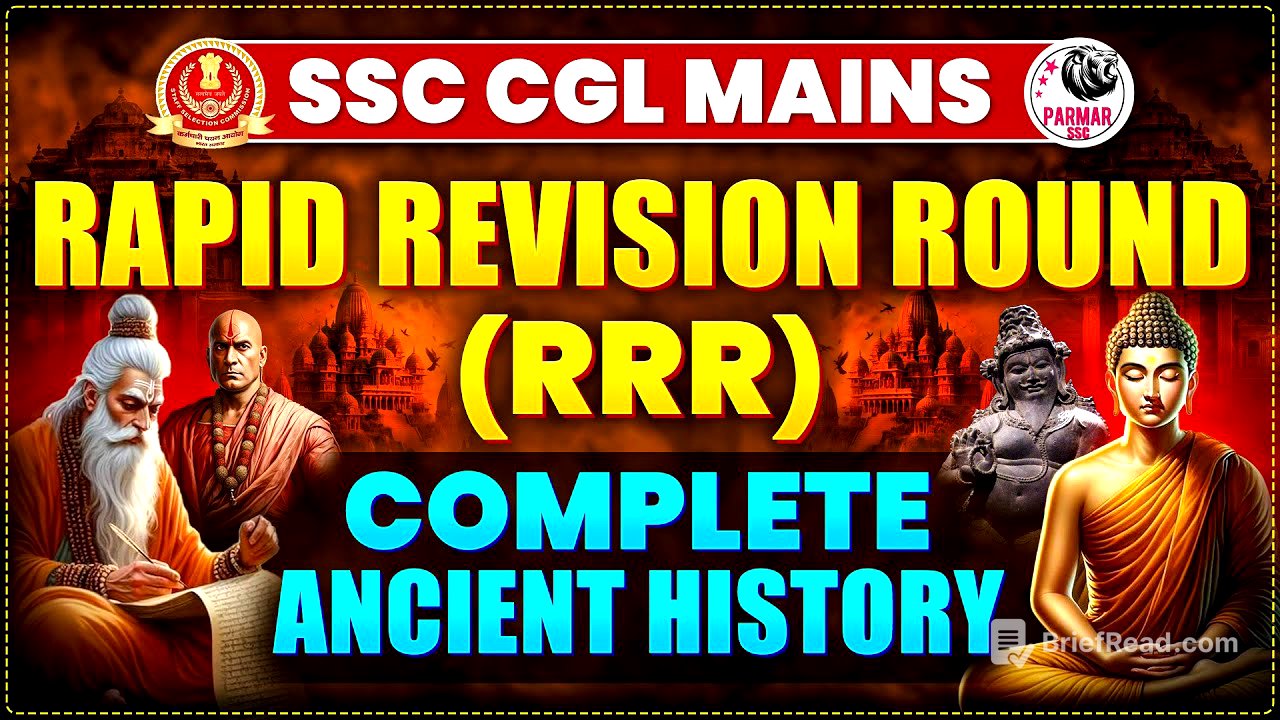TLDR;
This lecture covers Ancient Indian History, focusing on the Indus Valley Civilization, the rise of Mahajanapadas, the Mauryan Empire, post-Mauryan dynasties, and the Gupta Empire. It also touches on post-Gupta developments, including the rise of various kingdoms and dynasties.
- Indus Valley Civilization: Urban planning, trade, and technology.
- Mauryan Empire: Key rulers, administration, and Ashoka's inscriptions.
- Gupta Empire: Golden Age, rulers, and cultural contributions.
Indus Valley Civilization (IVC) [0:39]
The Indus Valley Civilization (IVC), also known as the Harappan Civilization, was an urban civilization situated along the Indus River. John Marshall was the Director-General of the Archaeological Survey of India (ASI) during its excavation, while Alexander Cunningham is known as the Father of ASI. The civilization spanned across Pakistan, Punjab, Haryana, and Rajasthan, reaching as far as Jammu and Kashmir in the north, Uttar Pradesh in the east, Sukta Kandor in the west, and Maharashtra in the south. Towns were divided into two parts: the higher town (Citadel or Acropolis) and the lower town, with exceptions like Chan Hud which was without a Citadel and Dholavira which was divided into three parts. The civilization was characterized by efficient town planning, a grid system, and an advanced drainage system. They were the first to produce cotton, known as "Sidon" to the Greeks. The tools were made of bronze, marking this period as the Bronze Age (2500-1750 BC). Trade was conducted with Mesopotamia (Iraq), with Harappan seals found there, and the Harappans were known as "Meluha" to the Mesopotamians. The script remains undeciphered, and weight measurements were in multiples of 16. Religious practices included the worship of male and female genital organs.
Key Sites of IVC [4:55]
Harappa, the first discovered site in 1921 by Dayaram Sahni, features six granaries in each row on the banks of the Ravi River and circular brick platforms. Mohenjo-daro, discovered in 1922 by RD Banerjee in the Sindh province of Pakistan, is one of the largest sites, featuring a clay figure of the Mother Goddess, the Great Bath, a large granary, and a beaded man made of steatite. Lothal in Gujarat is an ancient dockyard with fire altars and evidence of double burial. Kalibanga in Rajasthan has plowed fields and each house had its own well. Chan Hudo in Sindh, Pakistan, is a city without a Citadel, while Dholavira in Gujarat is divided into three parts and features a giant water reservoir. Surkotada has a single bone of a horse. Sukta Gador is a trading site near the Iranian border. Bhirana in Haryana is the oldest Indian civilization site, while Banawali in Haryana lacks a grid pattern but shows evidence of fortification.
Mahajanapadas [9:16]
Around the 6th century BC, Mahajanapadas originated in the northern part of India. Initially, they were Janapadas, but as territories grew, they became Mahajanapadas, totaling 16. Evidence of these is found in Buddhist literature like Anguttara Nikaya and Jain literature like Bhagwati Sutra. Key Mahajanapadas include Anga (Champa), Magadha, Kashi (Varanasi), Vatsa (Kaushambi), Kaushal (Ayodhya, Shravasti), Sur Sena (Mathura), Panchal (A Chitra, Kampal), Kuru (Indraprastha), fish (Virat Nagar), Avanti (Ujjaini, Mahishmati), Gandhara (Takshashila), Kamboj (question), Asmak (A Pratisthan or Pathan), Vajji (Vaishali), and Malla (Kusi Nara). Magadha emerged as the most powerful due to its advantageous position, with its capital Raj Gree surrounded by five hills and Pataliputra located at the bank of Ganga and Son.
Magadha Dynasty [12:38]
The first dynasty to rule Magadha was the Harika dynasty, with Bimbi Saar as its first ruler, who had a physician named Jeevak. Azad Enemy convened the first Buddhist council in 483 BC. Udan shifted the capital from Rajgiri to Pataliputra. The Shishu Nagar Dynasty included Shishu Nagar and Kala Shok, during whose rule the Second Buddhist Council was held. Alexander the Great invaded India in 326 BC, fighting Porus in the Battle of the Peace on the banks of the Jhelum River. Chandragupta Maurya then overthrew Dhananand, establishing the Maurya Dynasty.
Mauryan Empire [14:10]
Chandragupta Maurya, with the help of Katle (Vishnugupta or Chanakya), founded the Mauryan Empire by defeating Dhananand and Celik Nicator. He married Celik Nicator's daughter, Helina, and had a son named Bindusar, known as Amitra by the Greeks, who followed the Aajeevika sect. Ashok, Bindusar's son, ruled for 12 years and ascended the throne with the help of Radha Gupta, reportedly killing his 99 brothers. After eight years, he fought the Kalinga War in 261 BC, leading him to adopt Dhamma Ghosha over Beri Ghosha.
Ashoka's Inscriptions [16:07]
Ashoka's inscriptions are found on rocks and pillars, with 14 major rock edicts. James Princep first deciphered them in 1938. The language used is Prakrit, and the script is Brahmi, with Kharosthi used in the North Western part of India and Greek Aram in Afghanistan. The inscriptions refer to Ashoka as Dev Nami Piya Dashi. Key minor rock inscriptions are in Musky, Gujjar, Brahmagiri, and Nittur. The first pillar edict prohibits animal slaughter, and the 13th mentions the Kalinga War. Pillars are located in Lauria Raj, Lauria Nandgarh, and Ram Purva, with the bull of Ram Purva now in the President's House. The Sarnath pillar features four lions and various animals, serving as India's national emblem. Barabar Hill Caves were built during Ashoka's time in Bihar.
Mauryan Administration and Society [19:27]
During Ashoka's time, key officers included Sani Dhata (Chief Treasury Officer), Samarta (Collector General of Revenue), Akshay Patel (Accountant General), and Sita Daksh (responsible for Agriculture). Megasthenes described the municipal administration as having six committees with five members each and divided society into seven classes: Philosopher, Cultivator, Asker, Shepherd, Trader, Warrior, and Overshear. Megasthenes claimed there was no slavery in India, which contradicts Kautilya's Arthashastra, which outlines the Saptang Theory (Seven Element Theory) with King, Amat, District, Fort, Fund, Army, and Friends. There were two types of courts: civil and criminal. Taxes were 1/4 to 1/6 of the production. Key ports were Bharuch and Sopara on the western side and Tamra Lip on the eastern side. Sources of information include Kautilya's Arthashastra, Vishakha Dutta's Mudra Rakshas, Megasthenes' Indika, and Buddhist literature like Jatak.
Post-Mauryan Empire: Shunga Dynasty [22:40]
Pushyamitra Sunga, a general, assassinated the last Mauryan king and established the Shunga dynasty. His capital was Vidisha, and he followed Hinduism and Buddhism, building many stupas, including the Baruch Stupa, which depicts the story of Yaksha and Yakshini. Other stupas include the largest, Kesariya Stupa in Bihar, and Dhamek Stupa in Sarnath Varanasi. Agnimitra, Pushyamitra's son, was the hero of Kalidas's Malavika Agnimitra. Patanjali wrote Mahabhashya during this time. The Kanwa dynasty was established by Vasudev after killing Dev Bhooti, the last Shunga ruler.
Satavahana Dynasty and Post Mauryan Invasions [24:42]
The Satavahana dynasty, originating from Mahajanapada, had Kal Pathane Pratisthan as its capital, with Simuk Satva as its founder. They started coins made of lead, and Gautami's son Satak was considered their greatest ruler, defeating Satrap Nahapana. Ajanta and Ellora caves were built by the Satavahana dynasty, and they constructed Amaravati and Nagarjuna Konda stupas in Andhra country, using Prakrit language. After them, invasions from Central Asia occurred, with the Indo Greeks being the first to attack, led by Meander or Milind, whose dialogue with Nag Sen is written in Milind Panho. They were the first Greeks to make gold coins and introduced the Hellenistic form of art, known as Gandha Art.
Shaka, Parthian and Kushan Dynasties [26:44]
After the Greeks, the Shaka dynasty came into power. Vikramaditya Parmar defeated them in 57 BC, starting the Vikram Samvat era. The Shaka ruler, Rudra Daman, got the Junagadh Rock Inscription written, repairing the Sudarshan Lake made by Pushya Gupta Vaish in Chandragupta Maurya's court. After the Parthians, the Kushan dynasty, also known as Skin Yans, established their capital at Purush Pura (Peshawar) and later Mathura. Kujal Cut Fees is considered its founder, followed by Vima Cut Fees and Kanishka, the most powerful ruler, who convened the Fourth Buddhist Council and introduced the Portuguese form of gold coins. They controlled the Silk Route and introduced the Satrapi system. Ashu Ghosh wrote Buddha Charitra, Vatsayan wrote Kama Sutra, and Charak wrote Charak Samhita during this time.
Gupta Empire [29:34]
The Gupta Empire, from 310 AD to 540 AD, is known as the Golden Era. Shri Gupta was followed by Ghatot Kach and Chandragupta I, who took the title of Maharajadhiraja and started the Gupta Ra in 320 AD, issuing gold coin dinars. Samudra Gupta, his son, was the greatest king, never defeated, as known from Prayag Prashasti (Allahabad Pillar Inscription) composed by his court poet, Hari Sen. Key officers included Kumar At, Maha Dand Naika, and Dand Vigra's Officer of War. Chandragupta II killed his brother Ram Gupta and married Dhruva Devi.
Chandragupta II and Gupta Culture [31:04]
During Chandragupta II's reign, the Gupta Empire had its largest territory, achieved through matrimonial alliances, such as marrying his daughter Prabhavati Gupta to Rudra Sen II. The Mehrauli Iron Pillar inscription is associated with them. His court had Navratans like Amar Singha, Dhanwantri, Hari Sen, Kalidas, and Vital Bhatta. He took the title of Vikramaditya. Fa Hien, a Chinese traveler, visited during his time. Key works include Kalidas's books and Shudraka's Mrij Kati. Kumar Gapad I built Nalanda University. Skandagupta successfully resisted the Huns, but repeated invasions weakened the Gupta Empire.
Gupta Administration and Post Gupta Period [33:07]
The Gupta administration included taxes like Uparika and Hiranya. The Idol of Vara Protecting the Goddess Earth is in Vidisha, MP, and the Udayagiri Caves of MP are from Chandragupta II's time. The 10 Avtaar Temple is in Jhansi, Uttar Pradesh, and the oldest brick temple dedicated to Lord Krishna is in Kanpur, Uttar Pradesh. In the post-Gupta period, the Gupta Empire divided into smaller empires. The Pushyabhuti dynasty arose in Thanesar, Haryana, the Maukhari dynasty near Kannauj, and the God Province people in Bengal. Harshavardhan of the Pushyabhuti dynasty captured North India, ruling from 606 AD to 147 AD, making Kannauj his capital.
Harshavardhan and Chalukya Dynasty [36:10]
Harshavardhan's biography is Harsh Charitra, written by Ban Bhatt, who also wrote Kadambari. Harshavardhan wrote Ratnavali, Priyadarshika, and Nagan. The Chalukya ruler Pulakesin II defeated Harshavardhan when he tried to cross the Narmada River, taking the title of South Pateshwar. The Pallava dynasty, with its capital at Kanchi or Kanchipuram, was founded by Simha Vishnu and was known for its temple architecture and Dravid style temples. Pallavas built temples like Shore Temples and Kailash Nathar Temple in Mahabalipuram, built by Narasimha Second, and the Seven Rath Temple, built by Narasimha First.
Juan Jang and Chalukyas [39:07]
Juan Jang, a Chinese traveler, visited during Harshavardhan's time. The Chalukyas were divided into three branches: the Chalukyas of Badami, the Eastern Chalukyas of Vangi, and the Later Chalukyas or Western Chalukyas of Kalani. Pulakesin I founded the Chalukya dynasty of Badami. The architecture of Chalukya started the Vesara style of temple architecture. Key temples include Ravana Jo Fali Caves, Ladkhan Temple, and Durga Temple in Aihole, known as the Cradle of Indian Architecture, and the temples of Patta Dalal. The Virupaksha temple was built by Queen Lok Mahadevi.
Rashtrakuta Dynasty and Tri-Partite Struggle [42:11]
The Rashtrakutas, founded by Danti Durg, were tributaries of the Chalukyas. Danti Durg killed the last Chalukya ruler, Kirti Varma II, and established the Rashtrakuta dynasty, with its capital at Maan Khaitan. Krishna I built the Kailash Temple in Ellora. Krishna III defeated the Chola dynasty. The Tri-Partite Struggle for Kannauj involved the Gurjar Pratihar, Pal Dynasty, and Rashtrakuta dynasty. The Pal Dynasty was founded by Gopal, and the Gurjar Pratihar was founded by Nagbhatta. The Hoye Saal dynasty of Halle Beatu, with its capital at Dwar Samudram, built star-shaped temples like the Chenna Keshav Vishnu temple.









